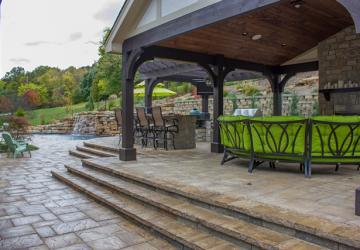In business for more than 15 years, Green Guys specializes in personalized landscape and hardscape design, installation and maintenance, as well as home construction and remodeling, pool design and property management.
SLHL: What are the advantages of using pavers for a patio as opposed to concrete?
Eric: In my opinion, pavers have a nicer look, adding a more authentic texture and color to the landscape. Pavers are also a great choice in St. Louis because they can adjust to the freeze-thaw cycle without cracking. If an individual paver is damaged, it easily can be repaired as good as new.
SLHL: There are so many colors and styles from which to choose. What is the key to mixing colors and materials in your outdoor living space for a beautiful outcome?
Eric: It is important to take in to account the surrounding context— the house color/material, any adjacent structures, and keeping in mind the overall desired aesthetic. It is important for the space to be in harmony with the existing conditions versus picking a paver you love by itself that does not fit the context.
SLHL: Is there a limit to the number of colors or materials you should use?
Eric: Yes, there is a limit, but it takes an experienced eye to truly know when enough is enough. As a general rule of thumb, simple is better. Adding too many textures and colors to a space via the hardscape can create a busy, chaotic space. The hardscape is an important piece of the landscape, but it needs to work in conjunction with the plant material and existing residence.
SLHL: What kind of maintenance is required for a stone or paver patio?
Eric: It depends on the material. Some natural stone masonry patios may require a sealer and/or periodic tuck-pointing to keep them in good condition. Paver patios are less maintenance, but they might need the joint sand to be reapplied every five to seven years, depending on the owner's preference. All patios should be power-washed and kept clear of leaf and dirt debris throughout the year to maximize their longevity.
SLHL: Why are stone and paver patios considered green?
Eric: There are some paver systems on the market that have been designed to allow water to percolate through the patio versus running off and into the storm-water sewer system. If the amount of impervious surface can be lessened it greatly reduces runoff, thereby decreasing the strain on natural water systems.
SLHL: Can you add pavers over an existing concrete patio?
Eric: Yes and no. If an existing concrete patio is in good shape – meaning, no substantial cracks or shifting – you could "dry-lay" pavers on top for a quick transformation. The downside is that if the concrete substrate cracks or shifts, you will find yourself needing to pick up the pavers and start over at some point. It is up to an experienced installer to assess the situation and give the homeowner the pros and cons to an overlay application.







